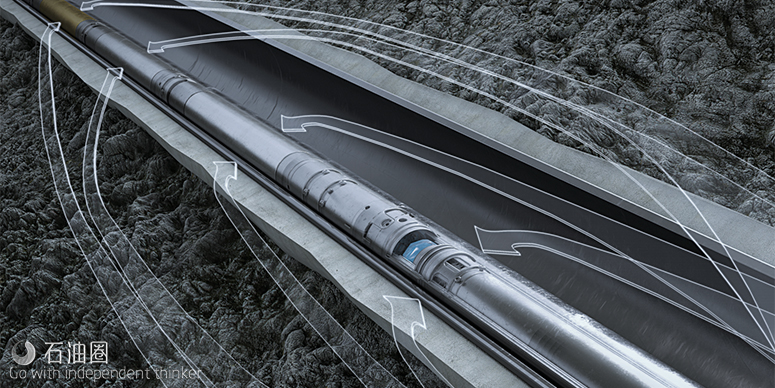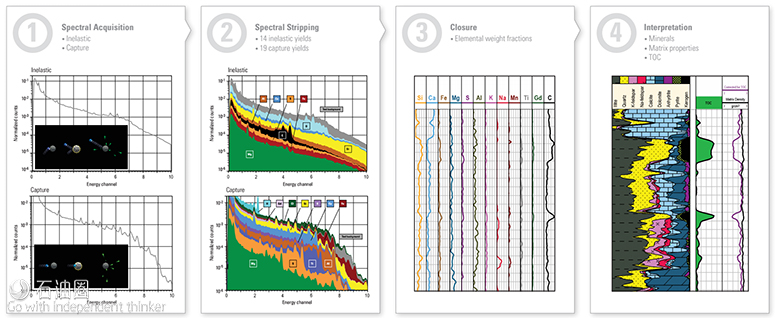Schlumberger has unveiled the Pulsar multi-function spectroscopy service at the SPWLA 58th Annual Symposium.
The new service is said to provide the industry’s first complete cased-hole formation evaluation and reservoir saturation monitoring with open-hole logging quality.
This next generation in pulsed neutron logging features multiple detectors and a high-output pulsed neutron generator to improve acquisition accuracy and increase both logging speed and measurement precision.
Understanding both the formation lithology and fluid content is critical for making timely, informed completions decisions, particularly in complex reservoirs. In cost-driven markets, the Pulsar service makes it possible to perform a complete rigless formation evaluation that does not disrupt drilling schedules.”
The new service simultaneously obtains self-compensated traditional cased-hole measurements, an expanded suite of elements including total organic carbon and the new fast neutron cross section (FNXS) measurement. Directly sensitive to the volume of gas in the formation, the FNXS measurement differentiates and quantifies gas-filled porosity from liquid-filled and tight zones without requiring any open-hole data input.
Pulsar multifunction spectroscopy service pairs multiple detectors with a high-output pulsed neutron generator to provide stand-alone cased hole formation evaluation and reservoir monitoring with openhole logging quality. No longer are operators limited in understanding their reservoir rock and fluid content for optimizing completion design and maximizing production.
Unlike conventional cased hole logging, no openhole data input is necessary to obtain a high-resolution volumetric petrographic interpretation, so rigless well logging can be conveniently conducted without disrupting drilling operations. Logging a well after it has been cased also negates well instability risks—especially in laterals and shale reservoirs.
Better data—and faster than previously possible
The high neutron output and improved acquisition accuracy of Pulsar service significantly increase logging speed and measurement precision in obtaining suite of self-compensated traditional cased hole measurements: sigma, porosity, carbon/oxygen ratio
expanded set of elements including total organic carbon (TOC)
new fast neutron cross section (FNXS) measurement that differentiates and quantifies gas-filled porosity from liquid-filled and tight zones.
Saturation determination in all well and reservoir environments
Because Pulsar service does not depend on conventional resistivity-based approaches to rock and fluid identification, it accurately determines saturations in any formation water salinity, and it can be deployed across a wide range of well conditions:
mineralogy, lithology, and fluid content profiles at any well inclination: horizontal, deviated, and vertical
hydrocarbon identification in low-resistivity pay
corrosion-resistant and NACE MR0175–compliant housing
unlimited operation time for the 1.72-in-diameter tool at up to 175 degC without a flask.
How it works
1. The spectroscopy workflow begins with the emission of neutrons by the pulsed neutron generator (PNG) of Pulsar service to induce the emission of gamma rays from the formation via two primary interactions: inelastic scattering and thermal neutron capture. Each of these interactions produces gamma rays with a specific set of characteristic energies.
The gamma rays are detected by the LaBr3:Ce scintillator coupled to a high-temperature spectroscopy photomultiplier, producing signals that are integrated, digitized, and processed by a high-performance pulse-height analyzer. The analyzer determines the pulse height (proportional to energy) of each detected gamma ray and accumulates pulse-height histograms (spectra) that tally counts versus pulse height. Spectra are acquired during and after each neutron burst, which enables clear separation of the inelastic and capture gamma rays.
2.Each spectrum is decomposed into a linear combination of standard spectra from individual elements. This step involves correction for some environmental and electronic factors.
Elemental weight fractions
3.The coefficients of the linear combination of the standard spectra are converted to elemental weight fractions via a modified geochemical oxides closure model or by using an inversion approach.
Interpretation
4.Two approaches are available to generate mineralogy and lithologic fractions from the elemental concentration logs. One is sequential SpectroLith spectroscopy lithology processing, which is based on the derivation of empirical relationships between elemental concentrations and mineral concentrations. The other is by using an iterative inversion technique, such as the the Quanti.Elan multicomponent inversion solver in the Techlog wellbore software platform.
APPLICATIONS
■Stand-alone formation evaluation for diagnosis of bypassed hydrocarbons, depleted reservoirs, and gas zones
●Differentiation of gas-filled porosity from very low porosity formations by using neutron porosity and fast neutron cross section (FNXS) measurements
■Petrophysical evaluation with greater accuracy by accounting for grain density and mineral properties in neutron porosity
■Total organic carbon (TOC) quantified as the difference between the measured total carbon and inorganic carbon
■Oil volume from TOC
■Hydrocarbon identification in low-resistivity pay
■Identification of oil zones in freshwater and mixed- or unknown-salinity reservoirs
●Formation evaluation in old wells where modern openhole logs have not been run
■High-fidelity mineralogy and lithology for geochemistry, stratigraphy, and rock typing
■Carbonates: Ca, Mg, Fe, Mn, and S to differentiate
and determine the volume of calcite, dolomite, anhydrite, and other carbonate minerals
■Siliciclastic rocks: Si, Al, Fe, K, Ca, and Mg as the primary elements to resolve quartz, feldspar, mica, and clay minerals
■More than 20 measured elemental concentrations routinely available to identify specific minerals, with additional elemental standards available on request
●Element logs for well-to-well correlation and sequence stratigraphy
■Environment-independent reservoir saturation monitoring
in any formation water salinity
●Production fluid profile determination for any well inclination: horizontal, deviated, and vertical
●Detection of water entry and flow behind casing
●Gravel-pack quality determination by using elemental spectroscopy
■Metals for mining exploration
■High-resolution determination of reservoir quality (RQ) and completion quality (CQ) for formation evaluation of unconventional reservoirs and complex lithologies on the basis of detailed quantitative mineralogy
●Rigless service deployment
FEATURES AND BENEFITS
■High-performance pulsed neutron generator (PNG)
●Optimized pulsing scheme with multiple square and short pulses for clean separation in measuring both inelastic and capture gamma rays
●High neutron output of 3.5 × 108 neutron/s for greater measurement precision
■State-of-the-art detectors
●Near and far detectors: cerium-doped lanthanum bromide (LaBr3:Ce)
●Deep detector: yttrium aluminum perovskite (YAP)
●Compact neutron monitor (CNM), photomultiplier, and counting electronics
●Excellent spectral energy resolution at high operating temperatures (175 degC [350 degF])
●Highest count rate capability in the industry
●Elimination of stabilization sources
●Calibrated measurement of elemental concentrations for Al, Ca, Fe, Gd, K, S, Si, Ti, Ba, Cl, H, Mg, Mn, Na, Br, O, and the metal Cu, with other elements on request
■In situ TOC measurement
■Borehole fluid- and completion-compensated sigma and thermal neutron porosity (TPHI) measurements
■Simultaneous acquisition of time and energy domain data
■Improved elemental precision delivering high-quality data even at faster logging speeds
■Extensive laboratory and modeling characterization to ensure accuracy in a wide range of environments
■Fully combinable hardware with the PS Platform* production services platform, SCMT* slim cement mapping tool, ThruBit* through-the bit logging services, and wireline tractor conveyance
■Corrosion-resistant and NACE MR0175–compliant housing

 石油圈
石油圈

